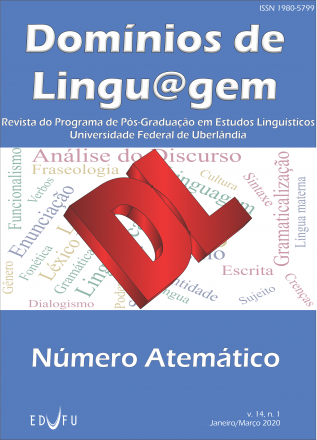"Nós vamos ter que dar dez beijos em cada um”: a gênese de discurso direto em um processo de escritura a dois
Domínios de Lingu@gem
Endereço:
Av. João Naves de Ávila, 2121 - Sala 1U-206 - Santa Mônica
Uberlândia / MG
38408-144
Site: http://www.seer.ufu.br/index.php/dominiosdelinguagem
Telefone: (34) 3239-4162
ISSN: 1980-5799
Editor Chefe: Guilherme Fromm
Início Publicação: 31/05/2007
Periodicidade: Anual
Área de Estudo: Linguística
"Nós vamos ter que dar dez beijos em cada um”: a gênese de discurso direto em um processo de escritura a dois
Ano: 2017 | Volume: 11 | Número: 4
Autores: Eduardo Calil, Kall Anne Sheyla Amorim Braga
Autor Correspondente: Eduardo Calil | [email protected]
Autor Correspondente: Eduardo Calil | [email protected]
Palavras-chave: Narrativa ficcional.Manuscrito escolar. Processo de escritura em ato.Discurso reportado.Discurso direto
Resumos Cadastrados
Resumo Português:
A escrita de falas de personagens (discurso direto) em narrativas ficcionais é um fenômeno linguístico-enunciativo complexo, envolvendo desdobramentos de diferentes planos enunciativos (passagem da voz do narrador para as vozes dos personagens e vice-versa), ao mesmo tempo em que requer do aluno o domínio de recursos gráficos e linguísticos para representá-las no texto escrito. Esta complexidade tem sido discutida pela literatura especializada a partir da análise de manuscritos escolares, onde as falas dos personagens já estão escritas. Apesar do produto textual ser um importante elemento para discutir como escreventes novatos podem representar o discurso direto, o texto acabado não permite observar como este discurso foi construído ao longo do processo de escritura. Partindo da Genética Textual e da Linguística Enunciativa, este trabalho discute o processo genético e criativo do discurso direto proposto por uma dupla de alunas recém-alfabetizadas (6-7 anos), quando o professor da turma solicitou que combinassem e escrevessem um único texto em sala de aula. Com o apoio do registro fílmico de todo o processo de escritura, a análise pôde identificar que a gênese textual da fala de um personagem passa por intensas (re) formulações antes de sua inscrição e linearização na folha de papel. Foi igualmente observado que a criação e o registro escrito do discurso direto são influenciados pelo conteúdo narrado, bem como pela condição letrada e subjetividade dos escreventes novatos.
Resumo Inglês:
The writing of the characters’ speech (direct speech) in fictional narratives is a complex linguistic-enunciative phenomenon, involving unfolding the enunciative plans (passage from the voice of the narrator to the voices of the characters and vice versa), at the same time as requires the student’s mastery of graphical and linguistic resources to represent them in the written text. This complexity has been discussed by the specialized literature from the analysis of school manuscripts, where the characters’ speech are already written. Although the textual product is an important element to discuss how newly writers can represent the direct speech, the finished text does not allow us to observe how this discourse was constructed throughout the writing process. Based on the Textual Genetics and the Enunciative Linguistics this work discusses the genetic and creative process of the direct speech proposed by a pair of newly literate students (6-7 years old), when the class teacher asked them to combine and write together a single text in the classroom. With the support of the filmic record of all the writing process, the analysis identified that the textual genesis of a character's speech undergoes intense (re) formulations prior to their inscription and linearization on the sheet of paper. It was also noted that the creation and written record of direct speech are influenced by the narrated content, as well asby the literate condition and subjectivity of the newly writer.

